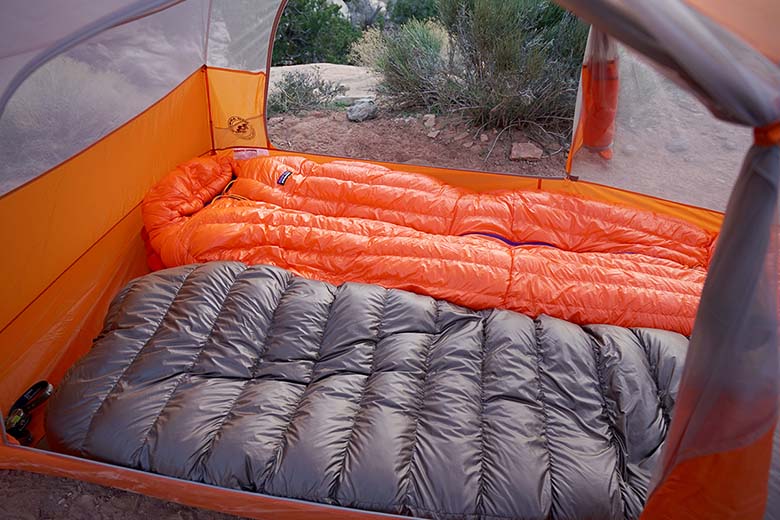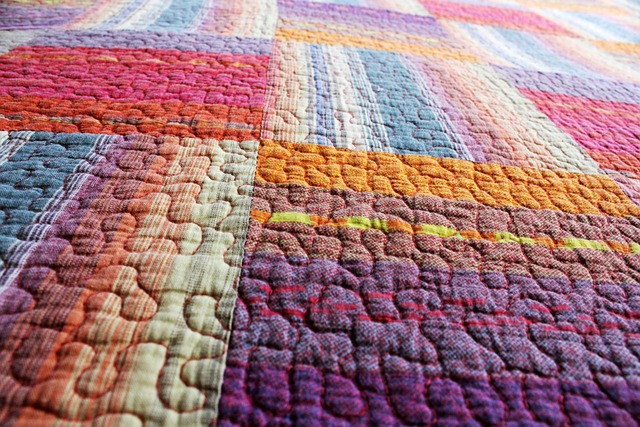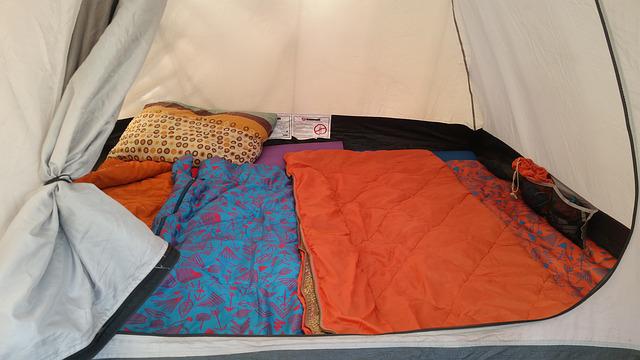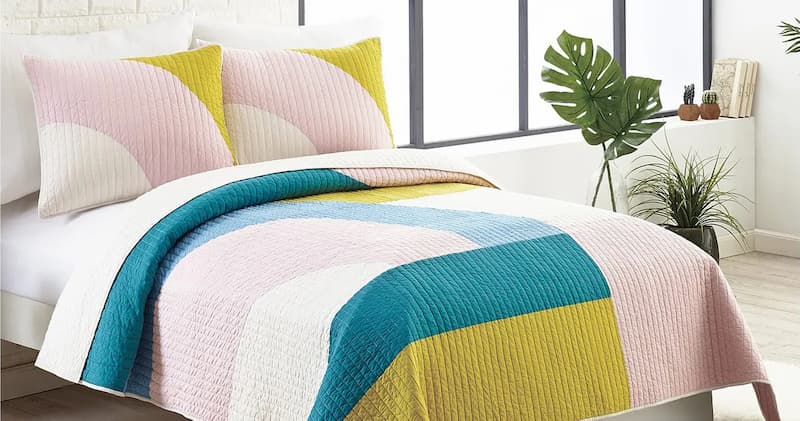
Quilt Vs Sleeping Bag: Pros & Cons & Which One Is The Best
What are the differences between quilt and sleeping bag?
In contrast to sleeping bags, which zip up to enclose you, quilts are flat like blankets, save for the footbox. Compared to sleeping bags, quilts are much lighter, and when used with an insulated sleeping pad, they can offer the same level of warmth.
Essentially, the main distinction between a sleeping bag and a quilt is that the latter is like the ultralight brother or sister of the former.
The ultralight hikers among us who need the lightest and most compact pieces of equipment will love quilts because they are made to be lightweight, highly compressible, and incredibly simple. On the other hand, because sleeping bags are available in a wider range of weights, sizes, and styles, they are frequently more adaptable for a wider range of adventures.
Table of Contents
The Difference Between A Camping Quilt & A Sleeping Bag
A camping quilt, as the name suggests, is a cover for your body while you sleep rather than a bag that you climb into and is surrounded on all sides. A camping quilt typically has no zip, but it does have a foot box which encloses around the bottom of your sleeping pad, and may have straps that wrap around the pad too. A camping quilt is roughly half as big as a sleeping bag and doesn’t have a hood for your head, but it is made of the same material and insulation. The end result is a camping quilt that is more compact, lighter, and easier to pack.
But does it actually keep you as warm and cozy as a sleeping bag while you’re asleep? Since your underside and your sleeping pad are in direct contact, there is no insulation between them. Let’s examine some of the key distinctions between sleeping bags and camping quilts in more detail.
Pros & Cons Of Quilts
Due to their extensive use of less insulation and materials than sleeping bags, quilts are typically lighter than sleeping bags. A quilt may be up to 50% smaller than a sleeping bag because it uses less down and fabric to make it. Another item that packs down impressively small is a down quilt, which typically shrinks to the size of a softball.
The quilt has a flexible design due to its construction. You might be able to expand it to become a straightforward down blanket, depending on the specific model you buy. For people who value variety, this may be pleasant.
Quilts can cost more than sleeping bags because they are a more recent piece of equipment. But you can find a quilt that will meet all of your sleeping needs and is still reasonably priced.

Pros & Cons Of Sleeping Bags
Like quilts, sleeping bags have benefits and drawbacks. A sleeping bag’s design means that staying warm won’t require you to fiddle with it or make any modifications. When you’re ready for bed, you can simply crawl into a sleeping bag rather than stressing over tossing and turning in your bag or having a foot escape into the cold. But because they also contain more fabric, they are typically heavier than quilts. And as we previously mentioned, that extra insulation might not be doing you much good.

When Talk About Ultralight Sleep Systems
Sleeping Bags
While traditional mummy bags are generally understood by outdoor enthusiasts, ultralight sleeping bags require a little more explanation. With thinner shell materials, higher-fill-power down, half-length (or shorter) zippers, and smaller dimensions, these light items streamline the mummy bag design (narrow at the feet, wider at the shoulders, and a hood around the head). Some ultralight bags even do away with the hood and zipper entirely in favor of a tube-style design that provides exceptional warmth for the weight (but at the expense of temperature regulation). It’s also crucial to point out that sleeping bags’ draft-free design completely encloses the body, including the head, keeping warm air in and cold air out, which contributes significantly to their effectiveness as insulators.
Backpacking Quilts
Backpacking quilts are more of a specialty item for ultralight backpackers and people who sleep in hammocks, but they are worth investigating for anyone looking to simplify their overnight gear. The idea behind a quilt’s construction is that your body weight compresses the feathers on the bottom of your bag, which means they don’t provide much insulation. The traditional mummy bag’s hood, back, and foot box are thus removed, leaving only the front and sides of the body with insulation provided by the quilt. While most designs have pad attachments to close the system with your sleeping pad, “top quilts” simply drape over the body.
Although not all quilts have rear closures, many do. This feature is useful if you’re not using a pad with your quilt and allows you to secure the quilt around you like a sleeping bag. These closures typically have 1 to 3 buckles or clips across the back opening to reduce weight. The ability to use a quilt as a blanket is also provided by some quilts’ foot boxes, which have bottom drawstrings and closures with a zipper or snaps. The quilt will stay around you while you sleep thanks to these closures, but they don’t offer much in the way of draft protection. In the end, quilts are frequently lighter than sleeping bags but also draftier.
Sleeping Bag/Quilt Hybrids
It’s important to note that there is a small subgroup of sleeping bag/quilt hybrids that still exhibits many traits from both. For instance, the Feathered Friends Flicker UL is essentially a hoodless sleeping bag with a full-length zipper, and the dimensions are such that you can completely enclose yourself. On hotter nights, however, it can be opened up like a quilt because it unzips all the way through the foot box and has a cinch closure there. Therm-a-Rest Ohm is another hybrid option with a comparable design but a slightly smaller package. Both are incredibly adaptable, ultralight sleeping systems that can be used as blankets for two in an emergency and transition from cold to warm better than most.
When Consider Performance
Warmth: Sleeping Bags
When it comes to warmth, sleeping bags are unquestionably the winner. The heat retention of a tightly closed bag and hood on a chilly night is difficult to match. On the other hand, quilts do not extend over the head to create a complete cocoon and cannot ensure a draft-free sleep, even when tightly fastened to a sleeping pad.
But it’s not as simple as we’d like it to be. In fact, when comparing a bag and quilt with the same temperature rating (say, the 30-degree REI Co-op Magma and Magma Trail), it’s typical to see more down fill in the quilt (2 ounces more in this case), which equates to more warmth (particularly on the top and sides of the body). In addition, many sleeping bags forego features like a hood or draft collar in order to reduce weight. This simplified style (found in bags like the Feathered Friends Tanager) significantly reduces a mummy bag’s capacity to trap heat, bringing it closer to the warmth of a quilt. The fact that quilts are not subject to the same EN/ISO standardized temperature testing as many sleeping bags further complicates the comparison (for more information, see our article on sleeping bag temperature ratings). Overall, you can anticipate that a fully functional sleeping bag with a comparable loft will be warmer than a quilt, but it’s critical to look further for accurate comparisons.
Not to mention, whether you’re using a sleeping bag or a quilt, your sleeping pad is a crucial part of your sleep system and should not be disregarded. When determining how well a sleeping pad will insulate you from the ground, most sleeping pads are given a warmth rating listed in R-value (ranging from roughly 1 to 8). Most 3-season hikers can generally stick with an R-value of 3 or 4, while winter campers will want to upgrade to an insulated model with an R-value of 6 or 7. With a 12-ounce weight, the Therm-a-Rest NeoAir XLite strikes a good balance between insulation and weight.) and a 3-season-ready R-Value of 4.2.
Weighing And Packing: Quilts
The back of a sleeping bag is an obvious area where ultralight enthusiasts can reduce weight and bulk in their packs. Quilts eliminate all unnecessary features from a bag in an effort to lose a few ounces, using less material and not including a hood or zipper. Additionally, they are typically the lighter and easier to pack items of equipment (although, as we already mentioned, it can be difficult to make accurate apples-to-apples comparisons). Take the 20 degree-rated Zpacks Solo Quilt and Western Mountaineering UltraLite sleeping bags, for instance. The amount of down in the two is roughly comparable (16 ounces of 850-fill and 13.7 ounces of 900-fill, respectively), but the UltraLite is heavier (29 ounces vs. the The 30-degree REI Magma quilt weighs only 0.8 ounces less than the 30-degree sleeping bag, so the difference isn’t always as pronounced as Solo’s 18.7 ounce weight.
Warmth-to-weight: Tie
Here, we put it all together using the warmth-to-weight ratio, the most accurate way to assess how effective a sleeping bag or quilt is. As we’ve already mentioned, since determining warmth is not an exact science, this comparison can be challenging. We’ll compare the Solo Quilt and Full Zip Sleeping Bag from Zpacks, both of which are rated to 20 degrees, to get the most accurate comparison. Both items are the same size and weight (13.7 ounces of down), but the quilt weighs 1 pound 2.7 ounces overall while the sleeping bag weighs 1 pound 5 ounces. The quilt is the undisputed winner in terms of warmth for the weight, according to the numbers alone (it contains the same amount of down for more than 2 oz. less), but remember that the zipperless design can be drafty. The quilt would win easily if drafts weren’t a problem (which they may not be for many people), but sadly the rules are not always clear-cut.
To find out if a quilt or bag has a competitive warmth-to-weight ratio, you should ultimately look at its individual specifications. There are some bags that are more effective than quilts, and vice versa. But let this be the one thing you take away from it: weight is not the only determining factor that will help you choose between a sleeping bag and quilt—nor should it necessarily be the first. Consider the additional key distinctions listed below.
Regulation Of Temperature: Depends On The Model
Both sleeping bags and quilts have advantages and disadvantages in terms of temperature regulation. We enjoy having our sleeping bag’s neck zippered past, the baffled collar fastened, and the hood pulled tight around our heads on chilly nights. And on a warm night, a bag with a full zip can be unzipped all the way and draped over our body to create a faux quilt. Although not all sleeping bags are created equal, especially ultralight ones, you run the risk of overheating on a warm night if you choose a model with a zipperless or partial-zip closure. In fact, we’ve slept in the Therm-a-Rest Hyperion 20 1/2-zip a lot of nights, switching between being too warm (inside the bag) and too cold (bag draped overtop). For a significant weight penalty, full-zip bags provide industry-leading temperature regulation (on cold and warm nights), whereas partial-zip or zipperless bags trade off lower weights for diminished temperature regulation.
But on nights other than the coldest, a quilt can be a great, lightweight option for controlling temperature. Simply lay the quilt over your body in warm weather to provide ventilation comparable to that of a warm down blanket. When it gets cold, a quilt with sleeping pad attachments will let you cinch your bag close to your body (a sleeping bag). Keep in mind that an ultra-lightweight “top quilt” (one without a pad attachment or a rear closure) cannot provide this level of temperature regulation. A quilt can’t really compete with a sleeping bag’s draft protection, as we’ve already mentioned, when you really want to batten down the hatches.
Ease Of Setup: Sleeping Bags
Sleeping bags are clearly superior when it comes to establishing your sleeping system. In fact, there is hardly any setup necessary—just empty your bag, lay it on your sleeping pad, and climb inside. Contrarily, dialing in your quilt takes a little more time, particularly if you plan to fasten it to your sleeping pad or close it using the back closures. Additionally, you can modify the fit of these attachments to get the right level of comfort, temperature control, or draft protection. It pays to “geek out” on your equipment and modify it for your particular use, as is typical with ultralight gear.
Purchasing Process: Tie
It may seem odd to bring up the purchasing process in this context, but given the differences between buying a sleeping bag and a quilt, we thought it best to do so. Cottage brands produce a large number of quilts, which are made to order and only offered online. Additionally, the phrase “custom-built” is important here: brands like You can select from up to 16 sizes (including various lengths and widths) and add or remove features like pad attachments, foot-box zippers, additional down fill, more durable face fabric, and more with Loco Libre, Katabatic, Hammock Gear, Enlightened Equipment, and Zpacks. This flexibility is a huge plus, especially for people with unusually small or large frames or ounce-counters seeking only what they require (and nothing more).
The majority of cottage-brand quilts, on the other hand, will take longer to reach your door due to their made-to-order nature, frequently taking a month or longer. Additionally, you won’t be able to “try on” these items before you buy them because they won’t be on the shelves of your neighborhood outdoor retailer. Additionally, most quilts don’t have an ISO-assigned temperature rating, which complicates comparisons. In contrast, most sleeping bags are produced by well-known companies, making them simple to locate and buy right away. With companies like REI, Western Mountaineering, and Therm-a-Rest attempting to play the ultralight game, quilts are nevertheless becoming more widespread. You won’t get the same level of customization that cottage brand products provide, but you will enjoy the convenience of an immediate purchase from a well-known retailer.
Why Choose Quilts Rather Than Sleeping Bags?
Quilts Are Lighter Than Sleeping Bags
Because of this reduced fabric, quilts are lighter than sleeping bags.
Let’s examine two products from Therm-A-Rest, for instance, both of which have the same temperature rating:
- Therm-A-Rest Vesper is a quilt rated to 20F, and it weighs 1lb 5oz
- Therm-A-Rest Parsec is a sleeping bag rated to 20F, and it weighs 1lb 15oz
The camping quilt therefore saves 10oz in this small example. Compared to a sleeping bag with the same temperature rating, this quilt is 33% lighter.
Quilts Are More Expensive Than Sleeping Bags
Unfortunately, this isn’t always the case, despite the fact that you might assume that a quilt would be the less expensive option because it uses fewer materials than a sleeping bag.
Even though they’re made from fewer materials and are structurally much simpler than sleeping bags, backpacking quilts tend to be the more expensive choice simply because there are only high-end quilts on the market. As of this writing, however, prices for quilts are becoming more common, as evidenced by the two Therm-A-Rest quilts I mentioned above.
A quilt can be found online or at a high-end outdoor retailer like REI, whereas a cheap, low-quality sleeping bag can be purchased almost anywhere. Additionally, only a small number of producers actually make quilts because they are currently more of a niche good for ultralight backpackers.
Many of these producers are what are known as “cottage” gear companies, which are very small and produce the majority of their gear by hand. A major contributing factor to the price of quilts is the use of extremely high-quality down (900 fill or higher) and extremely light shell fabrics.
The quilts’ current relatively high price is the result of a number of factors working against it. Although there are times when you can find quilts on sale, in general, you should expect to pay at least $200 and possibly more for your quilt. In contrast, you can find some good sleeping bags for less than that amount.
Will A Quilt Keep You As Warm As A Sleeping Bag
If used properly, a quilt can in fact keep you as warm as a sleeping bag. (check out our favorite sleeping bags if you’re interested in getting one) You should first make sure you have a warm sleeping pad if you intend to backpack with a quilt. Fair enough, a warm sleeping pad is equally essential to a sleeping bag.
In the end, a quilt with a temperature rating can keep you just as warm as a sleeping bag with a similar rating, but it takes more time and practice to get used to sleeping comfortably in a quilt. If you decide to purchase a quilt, our advice is to spend some time learning how to use it correctly so you can get the most warmth possible. Avoid doing this in the dead of winter; instead, do it in the summer or in the early fall or late spring when the temperatures are moderate.
Tips For Staying Warm With A Top Quilt
The warmth of sleeping pads is rated similarly to that of sleeping bags, but the rating is given in terms of “r-value” rather than “degrees.” In general, a sleeping pad will be warmer and more insulated the higher the R-value.
A hat, or even just a jacket with a warm hood, is something you’ll want to pack after getting a warm sleeping pad. You must keep your head covered if you want to avoid becoming cold at night since a quilt doesn’t have a hood.
Last but not least, if your quilt has a short zipper or other means of securing it around your feet, it may be worthwhile to tighten the fasteners or zip it up around your feet to help trap heat in this delicate area.
Typically, when you start to feel cold, your body’s blood vessels close and direct blood flow away from your extremities (like your feet) and toward your core. Despite the fact that this is excellent from a survival standpoint, it frequently leads to cold feet and discomfort at night when your toes are left out in the cold for too long. See more about Delta Comfort Plus Vs First Class

Are Quilts Better Than Sleeping Bags?
The answer to this question, like any good question, is, well, it depends. Quilts are better than sleeping bags in some ways but don’t quite live up to expectations in others.
For someone who travels in cool to warm climates where it doesn’t get too terribly cold at night, a quilt is a really great option. This isn’t because quilts don’t keep you warm, but rather, by eliminating the “mummy” shape of a sleeping bag in favor of weight savings, a quilt loses some of its overall heat retention properties as heat will escape from the sides of your body and around your head if you’re not fully covered by your quilt.
A quilt, on the other hand, might be a nice change of pace if you don’t like the feeling of being swaddled, which is fairly standard in a sleeping bag. It feels more like sleeping with your blanket at home than inside a constricting insulated sack. Therefore, quilts make up for any overall heat-retention efficiency losses with increased comfort.
However, quilts’ reduced bulk and lighter weight are what really appeal to backpackers. Quilts typically weigh less than sleeping bags and fold up into a relatively small size because they don’t have an underside or a hood. Many of us find this to be a great selling point because nobody likes to carry extra weight.
With that said, a quilt doesn’t have an underside, so you will need to bring a warmer sleeping pad than you would if you were using a proper sleeping bag. This is because there’s less material between you and the ground, so there’s less insulation keeping you warm. A warmer sleeping pad usually only adds a small amount of weight, so the overall weight of the sleeping pad and quilt combination is still less than that of a conventional sleeping bag.
The End
Both sleeping bags and quilts make excellent choices for keeping warm while camping. Although sleeping bags are more popular than quilts, the lightweight quilt is quickly gaining popularity in the backpacking community because it offers an alternative to a heavy, bulky sleeping bag.
Some people love quilts, while others don’t care much for them. It’s important to take the time to decide what will work best for your needs before rushing out to buy a fancy new quilt or sleeping bag. A great way to see how your equipment holds up before you find yourself in a more extreme environment is to test your new quilt or sleeping bag in moderate weather. Happy trails!


